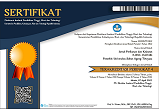Health Conditions and Spatial Variations in Rhizophora apiculata Population Characteristics in the Petroleum Industry Area and Non-Industry in Riau Province
Abstract
The current marine environment has begun to be polluted and will directly affect the biota around it. The study of health conditions and spatial variations in the characteristics of the population of Rhizophora apiculata was carried out in the mangrove ecosystem around the oil and non-industrial areas of Riau Province. This study aims at a baseline for evaluating mangrove management in Riau Province. Sampling is carried out using line transects drawn from the reference point (outermost mangrove stands) in a direction perpendicular to the coastline to the mainland and sample plots made with a size of 10 X 10 m2. Samples of leaves, fruits, and flowers are taken randomly based on the sample plots made. Then preserved with 70% alcohol and labeled. The preserved samples were taken to the laboratory to measure morphometrics and calculate the number of stomats. The results showed that the population of R. apiculata at all stations was in an unhealthy condition. In addition, individual competition and adaptability possessed by the population of R. apiculata are very low, ranging from 09.53 - 17.27% and illustrating more group growth and very high competition among individuals. Furthermore, the discriminant analysis shows that the morphometric variables that most characterize the population of R. apiculata in the oil industry with non-industrial areas are the length of the stem. Based on the results of PCA analysis, the variables that most determine the poor health of the population of R. apiculata are the parameters of Pb heavy metals, pH, temperature and DO waters.
Keywords
Full Text:
PDFReferences
Alongi DM. 2008. Mangrove forests: Resilience, protection from tsunamis, and responses to global climate change. Estuarine, Coastal and Shelf Science 76:1-13.
Alongi DM. 2014. Carbon cycling and storage in mangrove forests. Annual Review of Marine Science 6:195–219.
Baker JM. 1982. Mangrove swamps and the oil industry. Oil and Petrochemical Pollution 1:5-22.
Barbier EB. 2012. Progress and challenges in valuing coastal and marine ecosystem services. Review of Environmental Economics and Policy 6(1):1–19.
Barbier EB. 2014. A global strategy for protecting vulnerable coastal populations. Science 345(6202):1250-1251.
Bayas JCL, Marohn C, Dercon G, Dewi S, Piepho HP, Joshi L, Noordwijk MN, Cadisch G. 2011. Influence of coastal vegetation on the 2004 tsunami wave impact in west Aceh. Proceedings of The National Academy of Sciences 108(46):18612–18617.
Bayen S. 2012. Occurrence, bioavailability and toxic effects of trace metals and organic contaminants in mangrove ecosystems: A review. Environment International 48:84-101.
Bengen DG. 2000. Teknik Pengambilan Contoh dan Analisis Data Biofisik Sumberdaya Pesisir. PKSPL-IPB. Bogor (ID): IPB Pr.
Bengen DG. 2004. Pedoman Teknis Pengenalan dan Pengelolaan Ekosistem Mangrove. Pusat Kajian Sumberdaya Pesisir dan Lautan IPB. Bogor.
Bilal J. 1989. Long and short term effects of oil pollution on marine ecosystem in ASEAN regoin. Proceedings Joint CCOP/ASCOPE/NECOR Workshop on Regional (ASEAN) Oil Spill Contingency Planning/Oil Drift Model, Environmental Impact Analysis and Water Efflument from Plat Forms/Refineries. 1989 October 9-14.
Chan KM. 1995. Metallothionein: Potential biomarker monitoring heavy metal pollution in fish around Hong Kong. Marine Pollution Bulletin 31:411 - 415.
DOI: http://dx.doi.org/10.33512/jpk.v8i2.6643
Refbacks
- There are currently no refbacks.



_-_Copy1.png)